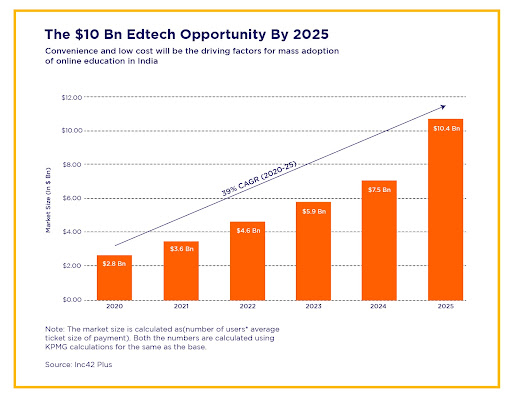India’s EdTech market size is expected to grow 3.7 times in the next five years, touching the $10.4 billion mark by 2025.

This estimated growth comes on the back of the pandemic, which propelled the need for tech-based solutions in education from “good to have” to “must-have”.
As COVID-19-induced lockdown took over, the Indian education system came to a complete halt, leaving just a few elite schools with tech capabilities to run remotely. While the majority of the private schools did adjust to the “new normal” in the subsequent months, this adaptation was tedious and insufficient, especially in the non-metro cities and rural areas.
The scenario not only left millions of school students without proper education but also widened the inequity in the learning opportunities. In fact, 80 percent of children in the country between the age of 14 and 18 reported lower levels of learning than when physically at school.
This heart-warming film by leading school ed-tech player LEAD is an ode to future line workers. This film captures the true essence of various struggles faced by people across the country during the testing times of the pandemic.
Putting a Pause in School Education
 The pandemic forced school students to continue their studies from home. This made sense theoretically. But the infrastructural lag owing to poor advancements and investments in the education ecosystem over the decades made this theory an impractical reality.
The pandemic forced school students to continue their studies from home. This made sense theoretically. But the infrastructural lag owing to poor advancements and investments in the education ecosystem over the decades made this theory an impractical reality.
In India, only 8 percent of homes with young members have computers with an internet connection.
So, initially, the schools themselves struggled to stay operational due to structural paucity. However, when they did “figure” things and tried to get the wheels rolling, the next roadblock was a bigger one: Many of their students didn’t have a proper device and stable internet connection to study remotely.
This brought an absolute pause in school education for millions of students for months.
Finding “Ways” With the Use of Technology in Education – #SchoolEdTech
The Indian economy is among the most resilient in the world – and so are its ways. Even with a big blow due to the ongoing pandemic, past the introspection on gaps unearthed during the lockdowns, Indian schools did manage to climb their way back. And that climb became possible partly because of the technological solutions these schools, as well as the students and teachers, adopted.
Smartphones bridged the snapped communication between schools and students.
According to the 2020 report on The Hindu, over 80 percent of students in India depend on mobile phones for learning.
School teachers started using online solutions, from Zoom and Google Classroom to Blackboard, Floop, and Slack. Private school owners, too, made infrastructural investments to amp their digital capabilities through ERPs and other EdTech solutions.
So, following the initial hiccups, technology came to aid many schools and teachers in creating a cohesive teaching environment where students learn online in a more effective way. The advantages of information technology in education became more known and prevalent in the mainstream.
Bridging the Gaps of Traditional Schooling
The changes the pandemic forced upon India’s school education system were, in many ways, much-needed. The existing infrastructure at the time was no better. The facilities that enable quality education and add more value for students were already missing for the majority of the private schools in the country.
India ranked 37th globally in quality of education, spending just 3.1 percent of its GDP in this sector.
Many private schools failed at basic structural requirements that students and teachers need for effective learning and teaching. Things were even worse in rural areas.
As per a 2019-2020 report, only 22.3 percent of schools had an internet connection. Moreover, 61 percent of schools in the country didn’t even have computers.
So, there were already significant gaps in the traditional system, which the pandemic exposed. However, the current scenario has also brought with it numerous opportunities – opportunities to recognize the gaps and address them with technology.
The Rise of #TechWithPurpose to Counter Ongoing Challenges
If history tells us anything, it’s that technology democratizes everything it touches. And now it’s time for #TechwithPurpose to revolutionize school education. In fact, the role of technology in education is more critical now than ever in addressing educational inequity. It has already made learning affordable, accessible, and efficacious. In particular, the use of technology in education in rural India is one of the biggest boons of recent times.
With help from apps and software, teachers can enhance their teaching ability and provide more value to the students. Private schools can benefit from technology through enterprise solutions. And students can enjoy an interactive learning experience.
In all, a deepened understanding of how technology helps in education has brought a new age of growth for all stakeholders. And as this understanding solidifies, more benefits and bigger impacts are expected moving forward.
Future Outlook: Promoting Innovation Through School EdTech Solutions
 Tech-driven innovations, in the mix with newer models to teach and learn, are what school owners, students, and teachers require to redefine the flawed traditional system with a better ecosystem.
Tech-driven innovations, in the mix with newer models to teach and learn, are what school owners, students, and teachers require to redefine the flawed traditional system with a better ecosystem.
Leading players in School ed-tech like LEAD have already played a key role in helping its partnering schools be tech-ready and resilient throughout.
LEAD powered schools get exclusive apps and tech solutions, along with end-to-end support, which has helped them stay put even during the lockdowns and in the ongoing situation.
As we move forward into a newer world where education is EVERYTHING, other such entities and schools must magnify the use of technology in education in India to achieve the cornerstone goal: Superior quality in school education with non-existent inequality.
 This article is authored by Anupam Gurani, Chief Marketing Officer, LEAD (Leadership Boulevard Pvt Ltd). Anupam plays a pivotal role in defining LEAD’s business and marketing strategies towards making LEAD India’s most loved EdTech brand and driving accelerated business growth.
This article is authored by Anupam Gurani, Chief Marketing Officer, LEAD (Leadership Boulevard Pvt Ltd). Anupam plays a pivotal role in defining LEAD’s business and marketing strategies towards making LEAD India’s most loved EdTech brand and driving accelerated business growth.



























